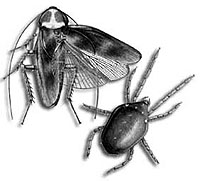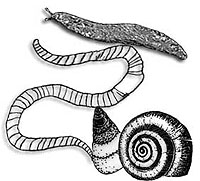|
All insects are invertebrates! All living things are placed into groups depending on common characteristics. The animal kingdom is informally divided into two groups, the vertebrates and invertebrates. Invertebrates are a group of animals that have no backbone, unlike animals such as reptiles, amphibians, fish, birds and mammals who all have a backbone. Classification or taxonomy is a means of arranging living things into orderly groups. These groups are mostly distinguished by structure and reflect evolutionary relationships. Standardised categories allow quick recognition of individuals and groups of similar organisms. There are 7 levels of classification, KINGDOM, PHYLUM, CLASS, ORDER, FAMILY, GENUS and SPECIES. The highest classification level "KINGDOM' incorporates organisms that share only a few important features. Modern taxonomy recognises five kingdoms.
As you move down through the levels, organisms are grouped into smaller and smaller groups. Individuals within each group become more alike, until you are left with a group of all the same type of organism i.e. all the same species.
Over 95% of all animals on the earth are invertebrates of one form or another. Invertebrates are found just about everywhere in both terrestrial and aquatic habitats, and include animals ranging from sponges, corals and seastars to insects, crabs and worms, just to name a few. For information on collecting aquatic invertebrates in freshwater environments see the Waterwatch site. Over 80% of all invertebrates are grouped into the single phylum Arthropoda that includes spiders, crustaceans, centipedes, millipedes and insects. All arthropods share the following common features:
Invertebrates or InsectsInsects are different from most other invertebrates. They are the largest Class of organisms and account for over 75% of all animal species. Insects can be separated from other invertebrates as they generally have 6 legs and conform to a common body plan. This body plan comprises of 3 parts, the head, thorax and abdomen although some parts may be more distinct than others. Particular insect orders may have some structures absent, reduced or greatly modified and some young stages can appear very different from their mature adult form. How to identify insects?If you would like to identify insects then you must learn the parts of their anatomy. There are three main parts which make up the body of an insect, each having a specific role. The HEAD, which is designed for feeding and sensory purposes and consists of one pair of compound eyes and up to 3 simple eyes, 1 pair of antennae and mouthparts, which may be piercing, chewing or sucking types depending on the insect. The THORAX, which is designed and is made up of 3 segments with each carrying 1 pair of legs. In some adult insects the last two segments of the thorax may support a pair of wings depending on the species. The ABDOMEN, which is designed for reproduction. The abdomen is the largest and softest of the 3 body parts. The abdomen houses all the organs vital for insect survival such as respiration, digestion and reproduction. Life CyclesInsects inhabit a diverse range of habitats, both terrestrial and aquatic and this is often reflected by the great diversity in their appearance. Most undergo some degree of change or metamorphosis during their life cycle and young may not have all of the adult insect features such as wings. Some insects, such as silverfish show no change throughout their lifetime except for an increase in body size. While other insects such as bugs or grasshoppers go through gradual stages of development, each successive stage (or nymph) is slightly more developed than the previous one. For example wings begin to develop from small wing buds and grow larger with each moult. Other insects such as moths or beetles are typical of insects that undergo a number of abrupt changes as they mature; egg - larvae - chrysalis/pupae - adult. In insects such as these, the wings develop inside the body and are visible only after the adult emerges from the pupal stage.
|
|||||||||||||||||||||||||||||||



